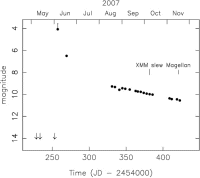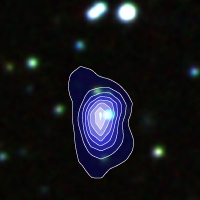XMM-Newton discovery of nova V598 Pup
18 July 2008
On 9 October 2007 XMM-Newton discovered a new bright X-ray source as it slewed across the sky. Follow-up optical observations from ground identified the counterpart to be a nova, V598 Pup.
|
|
|
Figure 1. Contours of Gaussian-smoothed XMM-Newton data of the slew survey source XMMSL1 J070542.7-381442 plotted over an optical image of the same region. |
The transient X-ray source was detected as part of the XMM-Newton Slew Survey. Data are recorded by the EPIC pn camera as the observatory slews between targeted observations. Comparing the slew data with archive data from the ROSAT mission (1990-1999) is an effective way to detect X-ray transient sources.
The source discovered on 9 October 2007 by A.M. Read et al. was given the designation XMMSL1 J070542.7-381442. (Slew sources are assigned a name using the survey prefix XMMSL1 and their J2000 sky coordinates.) It had a count rate of ~50 counts per second in the 0.2-2 keV band; this is ~750 times brighter than the upper limit at that position from the ROSAT archive.
The team then began the search for an optical counterpart. Three candidate sources which lay inside the slew error circle were identified. Ground-based follow-up observations were performed with the Magellan Clay 6.5m telescope on 16 November 2007.
In an image of the sky region around the X-ray source, one of the candidates, the normally ~16 mV star USNO A2.0 0450-03360039, was now found to be much brighter. A series of spectra, covering the wavelength range 350-1000nm, were taken of this star using the same telescope. These revealed characteristic emission lines allowing the star to be classified as a nova in a late post-outburst state.
 |
|
Figure 2. Optical light curve of nova V598 Pup for the period May-November 2007 (from the ASAS) |
The history of the optical brightness of the star was determined using archival data from the All Sky Automated Survey (ASAS). The extracted light curve revealed the star USNO A2.0 0450-03360039 to have experienced a sudden increase from its normal mV ~16 to mV <4 between 2 and 5 June 2007. This means it is one of the brightest novae ever recorded. Having been identified as a nova, the star was designated V598 Pup by the GCVS (General Catalogue of Variable Stars) acting on behalf the IAU.
A period of ~125 days lies between the peak brightness in the optical and the detection in X-rays by XMM-Newton. It is unusual for a nova to be discovered first through its X-ray emission.
Novae occur when material accreted from a companion star onto a white dwarf star reaches a critical density and ignites resulting in the majority of the material being blasted into space. The expelled gas is very bright at optical wavelengths. This is the period during which novae are usually discovered.
Initially the bright X-ray emission coming from the material burning on the surface of the white dwarf is absorbed by the expelled matter. Only when this matter becomes transparent to the X-rays can the emission from the surface be detected as well.
Additional targeted observations of V598 Pup were performed with XMM-Newton on 30 October 2007 and with NASA's Swift satellite on 21 November 2007. These showed that the X-ray flux was decreasing rapidly, with a drop by a factor of at least 15 between 9 October (original discovery) and 30 October and by another factor of 5 between 30 October and 21 November. It was fortunate that the XMM-Newton slew covered this region of the sky and discovered this bright nova.
The first XMM-Newton Slew Survey catalogue (that includes V598 Pup) is publicly available (see the links on the right-hand side of this page for access and detailed background information).
The constellation Puppis is situated south east of the constellation Canis Major - with the bright star Sirius - and is visible at all latitudes southward of ~40° N.
Related publication
Read, A.M. et al., "XMM-Newton slew survey discovery of the nova XMMSL1 J070542.7-381442 (V598 Puppis)", A&A, 482, issue 2, pp. L1-L4, DOI: 10.1051/0004-6361:200809456, May 2008

